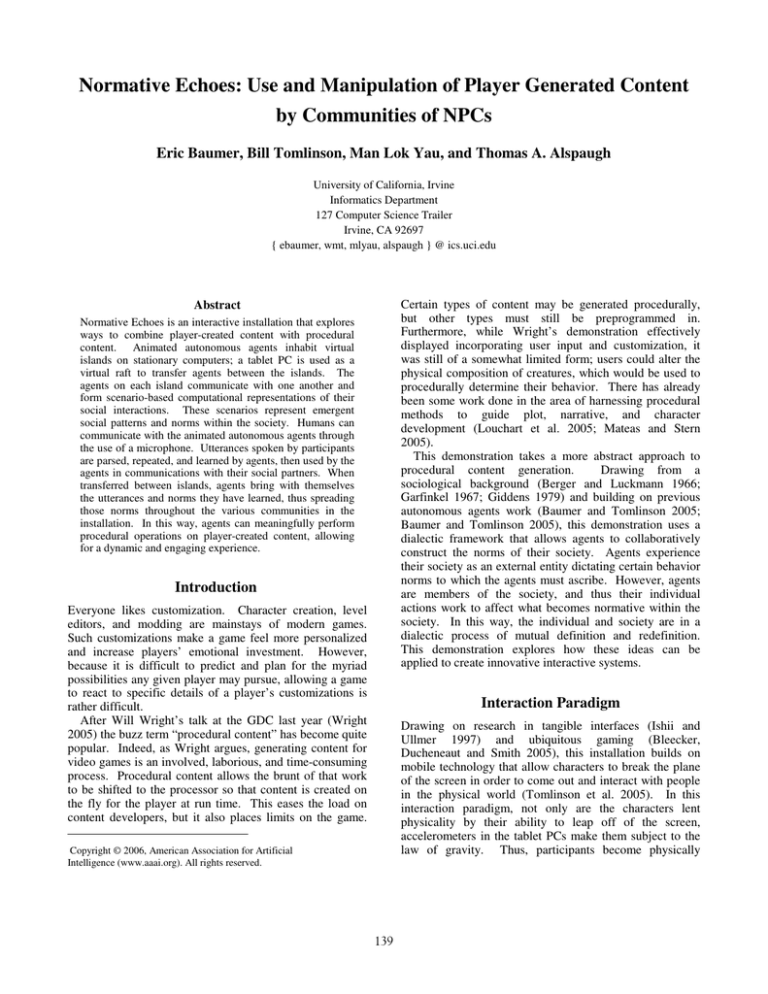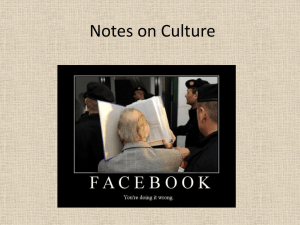
Normative Echoes: Use and Manipulation of Player Generated Content
by Communities of NPCs
Eric Baumer, Bill Tomlinson, Man Lok Yau, and Thomas A. Alspaugh
University of California, Irvine
Informatics Department
127 Computer Science Trailer
Irvine, CA 92697
{ ebaumer, wmt, mlyau, alspaugh } @ ics.uci.edu
Certain types of content may be generated procedurally,
but other types must still be preprogrammed in.
Furthermore, while Wright’s demonstration effectively
displayed incorporating user input and customization, it
was still of a somewhat limited form; users could alter the
physical composition of creatures, which would be used to
procedurally determine their behavior. There has already
been some work done in the area of harnessing procedural
methods to guide plot, narrative, and character
development (Louchart et al. 2005; Mateas and Stern
2005).
This demonstration takes a more abstract approach to
procedural content generation.
Drawing from a
sociological background (Berger and Luckmann 1966;
Garfinkel 1967; Giddens 1979) and building on previous
autonomous agents work (Baumer and Tomlinson 2005;
Baumer and Tomlinson 2005), this demonstration uses a
dialectic framework that allows agents to collaboratively
construct the norms of their society. Agents experience
their society as an external entity dictating certain behavior
norms to which the agents must ascribe. However, agents
are members of the society, and thus their individual
actions work to affect what becomes normative within the
society. In this way, the individual and society are in a
dialectic process of mutual definition and redefinition.
This demonstration explores how these ideas can be
applied to create innovative interactive systems.
Abstract
Normative Echoes is an interactive installation that explores
ways to combine player-created content with procedural
content. Animated autonomous agents inhabit virtual
islands on stationary computers; a tablet PC is used as a
virtual raft to transfer agents between the islands. The
agents on each island communicate with one another and
form scenario-based computational representations of their
social interactions. These scenarios represent emergent
social patterns and norms within the society. Humans can
communicate with the animated autonomous agents through
the use of a microphone. Utterances spoken by participants
are parsed, repeated, and learned by agents, then used by the
agents in communications with their social partners. When
transferred between islands, agents bring with themselves
the utterances and norms they have learned, thus spreading
those norms throughout the various communities in the
installation. In this way, agents can meaningfully perform
procedural operations on player-created content, allowing
for a dynamic and engaging experience.
Introduction
Everyone likes customization. Character creation, level
editors, and modding are mainstays of modern games.
Such customizations make a game feel more personalized
and increase players’ emotional investment. However,
because it is difficult to predict and plan for the myriad
possibilities any given player may pursue, allowing a game
to react to specific details of a player’s customizations is
rather difficult.
After Will Wright’s talk at the GDC last year (Wright
2005) the buzz term “procedural content” has become quite
popular. Indeed, as Wright argues, generating content for
video games is an involved, laborious, and time-consuming
process. Procedural content allows the brunt of that work
to be shifted to the processor so that content is created on
the fly for the player at run time. This eases the load on
content developers, but it also places limits on the game.
Interaction Paradigm
Drawing on research in tangible interfaces (Ishii and
Ullmer 1997) and ubiquitous gaming (Bleecker,
Ducheneaut and Smith 2005), this installation builds on
mobile technology that allow characters to break the plane
of the screen in order to come out and interact with people
in the physical world (Tomlinson et al. 2005). In this
interaction paradigm, not only are the characters lent
physicality by their ability to leap off of the screen,
accelerometers in the tablet PCs make them subject to the
law of gravity. Thus, participants become physically
Copyright © 2006, American Association for Artificial
Intelligence (www.aaai.org). All rights reserved.
139
involved in the act of helping the character balance on the
raft, increasing the level of engagement.
References
Alspaugh, T. (2005). Temporally Expressive Scenarios in
ScenarioML. Institute for Software Research Technical
Report UCI-ISR-05-06. University of California, Irvine.
Emergent Norms
As mentioned above, this installation draws on sociological
concepts such as norms and institutions. One of the aims
of this installation is to use a dialectic framework that
allows agents to develop their own societal norms and
institutions. The methods used here are similar to those
described in (Baumer and Tomlinson 2005). Individuals
form internal representations of their social interactions
using scenarios (Alspaugh 2005), and then those scenarios
guide future social action. When one pattern or scenario
occurs more frequently, it receives a higher weighting than
other scenarios and is thus more likely to be enacted in the
future. Furthermore, when an agent observes a known
scenario partially enacted, that agent may step in to
complete the scenario. However, agents can also act
outside of societal norms and not base their interactions on
already existing norms. This allows for a dialectic
framework, in which the norms of the society dictate
individual actions and individual actions simultaneously
define the society’s norms.
One advantage of using scenarios to represent these
norms is that it allows them to be stored in a format that is
both machine-readable and human-readable. Many AI
methods for controlling behavior, such as Bayesian nets or
machine learning, result in a behavioral control structure
that effectively produces a given behavior, but a human
cannot then examine that control structure to determine
how it functions. Since scenarios are described primarily
by events and the temporal relationships between them,
this representation is much more intelligible.
Such
intelligibility is important in processes such as debugging,
performance analysis, and algorithm optimization.
Baumer, E. and Tomlinson, B. (2005). Institutionalization
through Reciprocal Habitalization and Typification.
Second NASA Workshop on Radical Agent Concepts
(WRAC), NASA Goddard Spaceflight Center, Greenbelt,
MD, Springer.
Baumer, E. and Tomlinson, B. (2005). Synthetic Social
Construction for Autonomous Characters. AAAI Workshop
on Modular Construction of Human-Like Intelligence,
Pittsburgh, PA.
Berger, P. L. and Luckmann, T. (1966). The Social
Construction of Reality: A Treatise on the Sociology of
Knowledge. New York, Irvington Publishers, Inc.
Bleecker, J., Ducheneaut, N. and Smith, I. (2005).
Ubiquitous Computing, Entertainment and Games
Workshop. The Seventh International Conference on
Ubiquitous Computing (Ubicomp 2005).
Garfinkel, H. (1967). Studies in Ethnomethodology.
Englewood-Cliffs, NJ, Prentice-Hall.
Giddens, A. (1979). Agency, Structure. Central Problems
in Social Theory. A. Giddens. Berkeley, University of
California Press.
Ishii, H. and Ullmer, B. (1997). Tangible bits: towards
seamless interfaces between people, bits and atoms.
Proceedings of the SIGCHI conference on Human factors
in computing systems, ACM Press: 234--241.
Louchart, S., Aylett, R., Dias, J. and Paiva, A. (2005).
Unscripted Narrative for Affectively Driven Characters.
Artificial Intelligence and Interactive Digital
Entertainment, Marina del Rey, CA, AAAI Press.
Aims
Player-created content and procedural content present two
promising and exciting directions for game AI. Although
some work has already been done in combining the two,
this demonstration seeks to propose new methods and
approaches to procedurally generated and player-created
content. One important aspect to remember is that not all
player-created content is in-game. Indeed, players have
been creating their own content for years by the
development of social structures and institutions
surrounding gaming. What the game means per se may
not be nearly as interesting as what it means in situ, seen in
light of the social context in which it is situated. The
utterances spoken by the characters in the installation carry
only the meaning assigned to them by participants. In this
way, the demonstration seeks to elicit meaning from
participants by not positing any inherent, a priori meaning
to its components.
Mateas, M. and Stern, A. (2005). Structuring Content
within the Façade Interactive Drama Architecture.
Artificial Intelligence and Interactive Digital
Entertainment (AIIDE 05), Marina del Rey, CA, AAAI
Press.
Tomlinson, B., Yau, M. L., O'Connell, J., Williams, K. and
Yamaoka, S. (2005). The Virtual Raft Project: A Mobile
Interface for Interacting with Communities of Autonomous
Characters. CHI '05 extended abstracts on Human factors
in computing systems. Portland, OR, USA, ACM Press.
Wright, W. (2005). The Future of Content. San Francisco,
CA, Game Developer's Conference.
140




